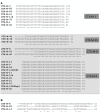CTX-M Enzymes: Origin and Diffusion
- PMID: 22485109
- PMCID: PMC3316993
- DOI: 10.3389/fmicb.2012.00110
CTX-M Enzymes: Origin and Diffusion
Abstract
CTX-M β-lactamases are considered a paradigm in the evolution of a resistance mechanism. Incorporation of different chromosomal bla(CTX-M) related genes from different species of Kluyvera has derived in different CTX-M clusters. In silico analyses have shown that this event has occurred at least nine times; in CTX-M-1 cluster (3), CTX-M-2 and CTX-M-9 clusters (2 each), and CTX-M-8 and CTX-M-25 clusters (1 each). This has been mainly produced by the participation of genetic mobilization units such as insertion sequences (ISEcp1 or ISCR1) and the later incorporation in hierarchical structures associated with multifaceted genetic structures including complex class 1 integrons and transposons. The capture of these bla(CTX-M) genes from the environment by highly mobilizable structures could have been a random event. Moreover, after incorporation within these structures, β-lactam selective force such as that exerted by cefotaxime and ceftazidime has fueled mutational events underscoring diversification of different clusters. Nevertheless, more variants of CTX-M enzymes, including those not inhibited by β-lactamase inhibitors such as clavulanic acid (IR-CTX-M variants), only obtained under in in vitro experiments, are still waiting to emerge in the clinical setting. Penetration and the later global spread of CTX-M producing organisms have been produced with the participation of the so-called "epidemic resistance plasmids" often carried in multi-drug resistant and virulent high-risk clones. All these facts but also the incorporation and co-selection of emerging resistance determinants within CTX-M producing bacteria, such as those encoding carbapenemases, depict the currently complex pandemic scenario of multi-drug resistant isolates.
Keywords: ISCR1; ISEcp1; Kluyvera spp.; antibiotic selective force; bacterial clones; blaCTX-M genes; gene mobilization; plasmid.
Figures





References
-
- Andrade L. N., Curiao T., Ferreira J. C., Longo J. M., Clímaco E. C., Martinez R., Bellissimo-Rodrigues F., Basile-Filho A., Evaristo M. A., Del Peloso P. F., Ribeiro V. B., Barth A. L., Paula M. C., Baquero F., Cantón R., Darini A. L., Coque T. M. (2011). Dissemination of blaKPC-2 by the spread of Klebsiella pneumoniae clonal complex 258 clones (ST258, ST11, ST437) and plasmids (IncFII, IncN, IncL/M) among Enterobacteriaceae species in Brazil. Antimicrob. Agents Chemother. 55, 3579–358310.1128/AAC.01783-10 - DOI - PMC - PubMed
-
- Angel Díaz M., Ramón Hernández J., Martínez-Martínez L., Rodríguez-Baño J., Pascual A., Grupo de Estudio de Infección Hospitalaria (GEIH) (2009). Extended-spectrum β-lactamase-producing Escherichia coli and Klebsiella pneumoniae in Spanish hospitals: 2nd multicenter study (GEIH-BLEE project, 2006). Enferm. Infecc. Microbiol. Clin. 27, 503–51010.1016/j.eimc.2008.09.006 - DOI - PubMed
LinkOut - more resources
Full Text Sources
Other Literature Sources
Miscellaneous

